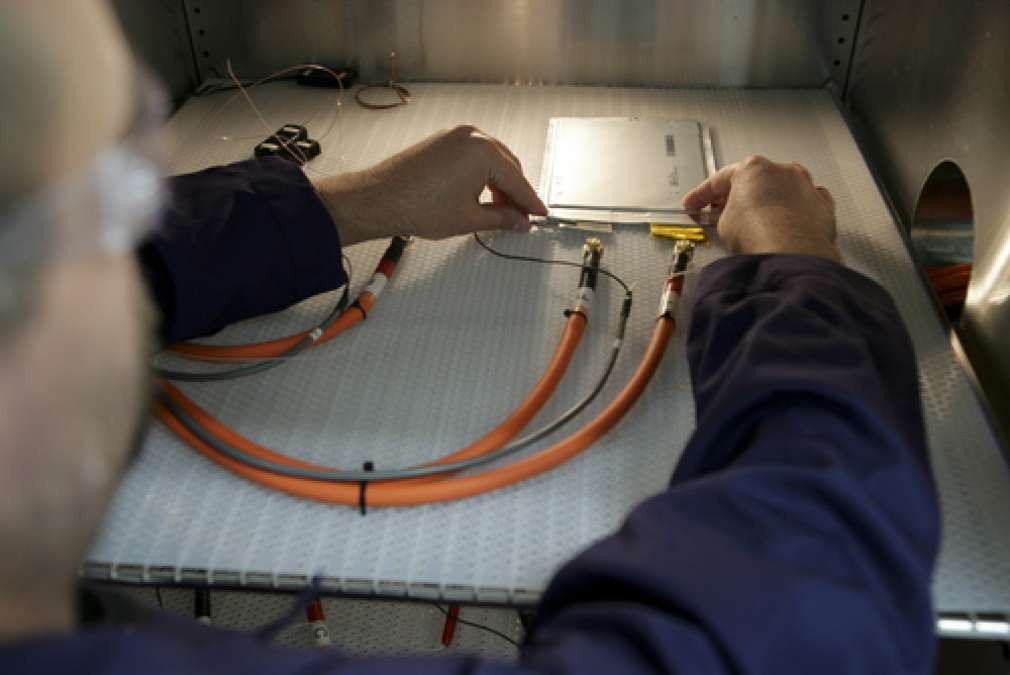Humans have a common pattern of distrusting the "new thing" just because it's "new". About a year ago news leaked out that a Chevy Volt had caught fire following a crash test in May 2011, and the firestorm of controversy was politically overhyped with ridiculously exaggerated claims, fitting that pattern. Yesterday it was reported that 16 Fisker Karma's flooded in New Jersey during Hurricane Sandy caught fire and burned in a storage lot, and it's possible this will reinvigorate distrust patterns. Fortuitously, a group in Germany, DEKRA Automobil GmbH, unveiled results over the weekend of fire safety tests they had conducted with lithium battery packs from electric and hybrid cars.
Their conclusion is that electric and hybrid cars containing lithium-ion batteries are at least as safe as gasoline powered cars. Fire and smoke is less in these cars than gasoline, there are no burning liquids that flow away from the burning car, however extinguishing a lithium-ion battery fire requires either more water or a special additive.
In the series of tests three battery packs from an unnamed electric vehicle currently on the market were set on fire, and then extinguished. "We wanted to find out how batteries really behave in a fire and when the fire is being extinguished and how much extinguishing agent is needed," says Markus Egelhaaf from DEKRA Accident Research.
The battery packs were set on fire with gasoline, but this raises the question of artificiality. An all electric car does not carry gasoline (a highly explosive liquid), but hybrid and plug-in hybrid cars do. For the forseeable future hybrids and plug-in hybrids will be more popular than all electric cars, and perhaps using gasoline to start the fire is meant to mimic an accident where burning gasoline pours onto a battery pack.
The test found that after a few moments of exposure to an 800 degree Centrigade flame, the batteries began to burn by themselves. This has been seen in other tests of lithium batteries, that there is an ignition temperature (as is true for most materials in the universe) above which these batteries catch fire. Testers found much less flame and smoke emanating from the packs. Internal pressure built up in cells, but was released when the cells burst. Each burst cell caused a small flash fire, which the testers described as "less intense than those seen in petrol fires."
Egelhaaf adds: "The risk of the fire rapidly spreading is lower in battery fires because unlike in vehicles that use conventional fuels such as petrol or diesel, burning liquid cannot flow away and set neighbouring objects alight."
Earlier generations of lithium batteries used pure lithium metal, rather than the lithium-ion chemistries used today. Lithium is a highly flammable metal in its pure state, but when chemically bonded with other materials can be very safe (depending on the material). Electric cars all use lithium-ion battery chemistries for this very reason.
In their initial attempts to extinguish the battery fire, they could put the fire out using water but the battery tended to relight itself afterward. This indicated the battery had to be cooled further after putting out the fire, which was simply accomplished by pouring on more water. They also tested two agents that produce additional cooling. One agent is a gel that doesn't flow away, but remains on the burning object creating additional cooling. The second reduces surface tension of water, increasing its evaporation rate, and also producing additional cooling. "Both substances proved highly effective at extinguishing the fire in our tests too," reports the DEKRA expert. "The fire was put out with much less water and in much less time."
"Safety issues are key to increased popularity of electromobility - and that includes fire protection," says Andreas Richter, who works in the DEKRA Electromobility Competence Center and coordinates all the company's activities in this area. "Are drivers of electric vehicles literally sitting in the hot seat? Are fire brigades capable of extinguishing fires from electric vehicles? This is debated extensively in places such as Internet forums. Our fire tests will now make a qualified and constructive contribution to this discussion."





